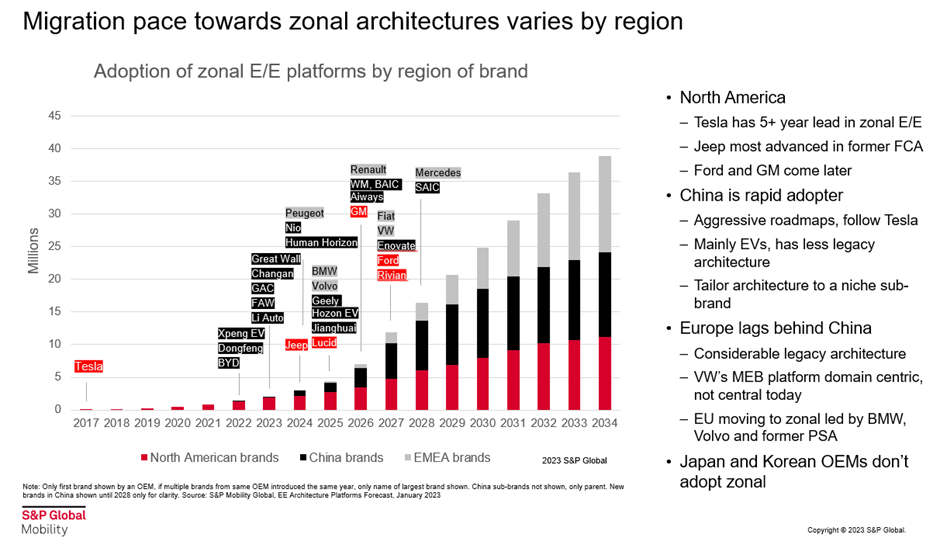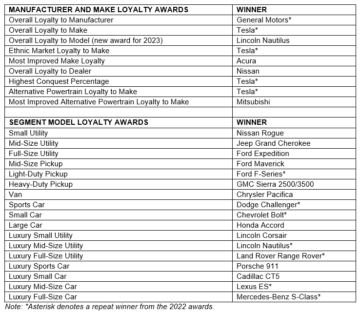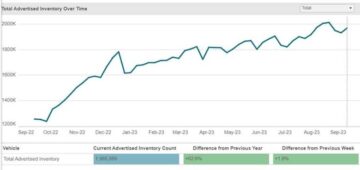Zonal architecture advancements are disrupting the
supply chain
The development of high-end battery electric vehicles has led to
the transformation of vehicles’ computing processes – using
centralized or zonal architectures that reduce the number of
electronic control units (ECUs) and wiring in the vehicle.
The use of zonal controllers in future centralized vehicle
architecture is expected to reduce cost, complexity, and assembly
time. The new architecture will present opportunities for suppliers
of MCUs, System-on-Chip (SoC), and Domain controllers- but pose a
long-term threat to traditional infotainment suppliers. It also
means significant software hurdles for OEMs offering a wide array
of available features and functions.
Domain controllers are essentially more powerful ECUs that take
care of local domains such as the infotainment, powertrain,
chassis, and driver-assist controls. By using domain-agnostic
hardware that manages local functions, the shift to zonal
architecture can potentially reduce wiring by up to 50%. Such
implementation has been seen in the Tesla Model 3, which has a
claimed assembly time of just 10 hours. With zonal designs, car
manufacturers can develop more efficient electric vehicles with
lower weight and extended range capabilities.

The trend towards zonal architecture comes from the need for
high-performance computers in the car to be able to communicate at
high speed (Ethernet) with the rest of the existing low-speed
network. To this end, 38% of all vehicles produced by 2034 are
expected to have zonal architecture, up from 2% in 2022.
This acceleration is also driven by the increasing
electrification of vehicles, particularly from new EV manufacturers
such as Tesla and Nio, who are not hamstrung by legacy
architectures. Currently, Tesla holds a five-year head-start on
their competitors, but Chinese companies are aggressively pursuing
this hardware design as well. Many other car brands are in the
process of implementing zonal architecture in the next few
years.
One of the traditional challenges facing carmakers is the high
cost of hardware, which can be offset by reducing wiring and system
complexity. In the first instance, body electronics, powertrain
domains, and vehicle dynamics will benefit from ECU integration and
improved wiring reduction using advanced zonal architecture. ADAS
and cockpit data management will remain in the realm of domain
controllers, which shift toward more centralized designs with the
introduction of central computers that could consolidate these two
domains. Of course, this consolidation implies revenue loss for
certain parts of the supply chain.

What’s more, such implementation may be more complicated than it
appears. Automakers will face challenges transitioning to a
centralized hardware architecture using fewer, more powerful blocks
and will progress at different rates. Volkswagen, for example,
faces software complexity in managing all the functionality and
features for its massive portfolio of vehicles across mainstream
and luxury brands. As a result, the company’s single software
platform model has been delayed; the new center computer
architecture with zone design will only emerge with the very
delayed Software Scalable Platform (SSP) program beyond 2030.
Meanwhile, Japanese and Korean OEMs are not initially
developing zonal controls, committing instead to developing
software-defined vehicles and introducing a centralized gateway –
or body domain controller – which also consolidates the existing
vehicle architecture. That said, as the degree of center computing
evolves, some type of local or zone ECU design is inevitable.
The evolution of architecture in China tends to happen quicker,
with companies like Nio already having a roadmap for zone
architecture by 2024. Meanwhile, as the individual domain
controllers coalesce into center computers, the shift benefits
suppliers of various domain controllers such as Aptiv, Denso,
Bosch, and Veoneer while also creating opportunities for suppliers
such as NVIDIA, Mobileye, and Qualcomm, companies that will provide
high-performance SoCs to power these computers.
Nearly all OEMs are considering the advantages of zonal
architecture for their coming vehicle designs. They can save costs
by using fewer but more powerful hardware units across different
segmentations and markets and scale up by updating vehicle features
through their software. To do so, OEMs must align their portfolios
with the roadmap of big semiconductor suppliers – such as Qualcomm
and Nvidia – to ensure they have the necessary processing power for
their vehicles.
Suppliers that can adapt to this new architecture – and
synchronize hardware, software, and vehicle platform cadences –
will be well-positioned to succeed, while those who fail to adapt
will find themselves at a disadvantage.
This article was published by S&P Global Mobility and not by S&P Global Ratings, which is a separately managed division of S&P Global.
- SEO Powered Content & PR Distribution. Get Amplified Today.
- PlatoAiStream. Web3 Data Intelligence. Knowledge Amplified. Access Here.
- Minting the Future w Adryenn Ashley. Access Here.
- Source: http://www.spglobal.com/mobility/en/research-analysis/be-ready-for-the-coming-shift-in-automotive-computing-power.html
- :has
- :is
- :not
- ][p
- $UP
- 10
- 2%
- 2022
- 2024
- 2030
- 320
- a
- Able
- acceleration
- across
- adapt
- ADAs
- advanced
- advancements
- advantages
- align
- All
- already
- also
- and
- aptiv
- architecture
- ARE
- Array
- article
- AS
- Assembly
- At
- automakers
- automotive
- available
- battery
- Battery Electric Vehicles
- BE
- been
- benefit
- benefits
- Beyond
- Big
- Blocks
- body
- Bosch
- brands
- but
- by
- CAN
- capabilities
- car
- care
- Center
- central
- centralized
- certain
- chain
- challenges
- chassis
- China
- chinese
- claimed
- coalesce
- Cockpit
- COM
- comes
- coming
- committing
- communicate
- Companies
- company
- competitors
- complexity
- complicated
- computer
- computers
- computing
- computing power
- considering
- consolidate
- Consolidates
- consolidation
- control
- controller
- controls
- Cost
- Costs
- could
- course
- Creating
- Currently
- data
- data management
- Degree
- Delayed
- Design
- designs
- develop
- developing
- Development
- different
- Disadvantage
- Division
- do
- domain
- domains
- driven
- dynamics
- efficient
- Electric
- electric vehicles
- Electronic
- Electronics
- end
- ensure
- essentially
- EV
- evolution
- evolves
- example
- existing
- expected
- Face
- faces
- facing
- FAIL
- Features
- few
- fewer
- Find
- First
- For
- from
- functionality
- functions
- future
- gateway
- Global
- happen
- Hardware
- hardware design
- Have
- having
- High
- High-End
- high-performance
- holds
- HOURS
- Hurdles
- implementation
- implementing
- improved
- in
- increasing
- individual
- inevitable
- initially
- instance
- instead
- integration
- into
- introducing
- Introduction
- IT
- ITS
- Japanese
- just
- Korean
- Led
- Legacy
- like
- local
- long-term
- loss
- Luxury
- Mainstream
- managed
- management
- manages
- managing
- Manufacturers
- many
- Markets
- massive
- May..
- means
- Meanwhile
- Mobileye
- mobility
- model
- more
- more efficient
- necessary
- Need
- network
- New
- next
- nio
- number
- Nvidia
- of
- offering
- offset
- on
- only
- opportunities
- or
- Other
- particularly
- parts
- platform
- plato
- Plato Data Intelligence
- PlatoData
- portfolio
- portfolios
- potentially
- power
- powerful
- present
- process
- processes
- processing
- Processing Power
- Produced
- Program
- Progress
- provide
- published
- qualcomm
- quicker
- range
- Rates
- ratings
- ready
- realm
- reduce
- reducing
- remain
- REST
- result
- revenue
- roadmap
- s
- S&P
- S&P Global
- Said
- Save
- scalable
- Scale
- seen
- semiconductor
- separately
- shift
- significant
- single
- So
- Software
- some
- speed
- succeed
- such
- suppliers
- supply
- supply chain
- system
- Take
- Tesla
- than
- that
- The
- their
- themselves
- These
- they
- this
- those
- threat
- Through
- time
- to
- toward
- towards
- traditional
- Transformation
- transitioning
- Trend
- type
- units
- updating
- use
- using
- various
- vehicle
- Vehicles
- very
- volkswagen
- was
- weight
- WELL
- which
- while
- WHO
- wide
- will
- with
- years
- zephyrnet










